Active Thermoelectric Vacuum Sensor Based on Frequency Modulation
Abstract
1. Introduction
2. Working Principle and Design of Proposed Metal-N-Poly Thermoelectric-Type Sensor
2.1. Sensing Scheme for Thermoelectric-Type Sensor Based on Frequency Modulation
2.2. Design and Fabrication of Thermoelectric-Type Sensor
3. Vacuum Measurement
3.1. Experiment Setup
3.2. Signal Acquisition from Thermoelectric-Type Sensor
4. Results and Analysis of Vacuum Measurement
4.1. Frequency Response
4.2. Modeling Under-Frequency Modulation
4.3. Sensitivity of Thermoelectric Vacuum Sensor
4.4. Responsivity and Heating Power
5. Conclusions
Author Contributions
Funding
Conflicts of Interest
References
- Wilfert, S.; Edelmann, C. Miniaturized vacuum gauges. J. Vac. Sci. Technol. A Vac. Surf. Film. 2004, 22, 309–320. [Google Scholar] [CrossRef]
- Piotto, M.; Del Cesta, S.; Bruschi, P. A CMOS compatible micro-Pirani vacuum sensor based on mutualheat transfer with 5-decade operating range and 0.3 Pa detection limit. Sens. Actuators A Phys. 2017, 263, 718–726. [Google Scholar] [CrossRef]
- Tseng, S.H.; Fang, C.L.; Wu, P.C.; Juang, Y.Z.; Lu, S.C. A CMOS MEMS thermal sensor with high frequency output. In Proceedings of the IEEE Sensors Conference, Lecce, Italy, 26–29 October 2008. [Google Scholar]
- Chen, C.N.; Huang, W.C. A CMOS-MEMS Thermopile with low thermal conductance and a near-perfect emissivity in the 8-14-μm wavelength range. IEEE Electron Device Lett. 2011, 32, 96–98. [Google Scholar] [CrossRef]
- Lin, K.S.; Chen, R. Design and fabrication of CMOS-integrated Thermoelectric IR Microsensors. In Proceedings of the IEEE/LEOS International Conference on Optical MEMs and Nanophotonics, Freiburg, Germany, 11–14 August 2008. [Google Scholar]
- Van Herwaarden, A.W.; Sarro, P.M.; Meijer, H.C. Integrated Vacuum Sensor. Sens. Actuators 1985, 8, 187–196. [Google Scholar] [CrossRef]
- Paul, O.; Brand, O.; Lenggenhager, R.; Baltes, H. Vacuum gauging with complementary metal-oxide-semiconductor microsensors. J. Vac. Sci. Technol. A Vac. Surf. Film. 1995, 13, 503–508. [Google Scholar] [CrossRef]
- Van Herwaarden, A.W.; Sarro, P.M. Thermal sensors based on the seebeck effect. Sens. Actuators 1986, 10, 321–346. [Google Scholar] [CrossRef]
- Van Herwaarden, A.W.; Sarro, P.M. Performance of integrated thermopile vacuum sensors. J. Phys. E Sci. Instrum. 1988, 21, 1162–1167. [Google Scholar] [CrossRef]
- Sun, X.; Xu, D.; Xiong, B.; Wu, G.; Wang, Y. A wide measurement pressure range CMOS-MEMS based integrated thermopile vacuum gauge with an XeF2 dry-etching process. Sens. Actuators A Phys. 2013, 201, 428–433. [Google Scholar] [CrossRef]
- Grau, M.; Volklein, F.; Meier, A.; Kunz, C.; Kaufmann, I.; Woias, P. Optimized MEMS Pirani sensor with increased pressure measurement sensitivity in the fine and rough vacuum regimes. J. Vac. Sci. Technol. A Vac. Surf. Film. 2015, 33, 021601–021606. [Google Scholar] [CrossRef]
- Kuo, J.T.W.; Yu, L.; Meng, E. Micromachined Thermal Flow Sensors—A Review. Micromachines 2012, 3, 550–573. [Google Scholar] [CrossRef]
- Gorecka-Drzazga, A. Miniature and MEMS-type Vacuum Sensors and Pumps. Vacuum 2009, 83, 1419–1426. [Google Scholar] [CrossRef]
- Johnson, R.G.; Higashi, R.E. A highly sensitive silicon chip microtransducer for air flow and differential pressure sensing applications. Sens. Actuators 1987, 11, 63–72. [Google Scholar] [CrossRef]
- Chen, S.J.; Shen, C.H. A Novel Two-Axis CMOS Accelerometer Based on Thermal Convection. IEEE Trans. Instrum. Meas. 2008, 57, 1572–1577. [Google Scholar] [CrossRef]
- Moser, D.; Lenggenhager, G.; Wachutka, R.; Baltes, H. Fabrication and Modelling of CMOS Microbridge Gas-flow Sensor. Sens. Actuators B Chem. 1992, 6, 165–168. [Google Scholar] [CrossRef]
- Boyer, A.; Cisse, E.; Azzouz, Y. Medium-power thermopiles using thin-film technology. Sens. Actuators A Phys. 1990, 24, 217–220. [Google Scholar] [CrossRef]
- Randjelovic, D.; Petropoulos, A.; Kaltsas, G.; Stojanovic, M.; Laziu, Z.; Djuriu, Z.; Matic, M. Multipurpose MEMS thermal sensor based on thermopiles. Sens. Actuators A Phys. 2008, 141, 404–413. [Google Scholar] [CrossRef]
- Volklein, F.; Blumers, M.; Schmitt, L. Thermoelectric microsensors and microactuators (MEMS) fabricated by thin film technology and micromachining. In Proceedings of the 18th International Conference on Thermoelectrics, Baltimore, MD, USA, 29 August–2 September 1999. [Google Scholar]
- Van Herwaarden, A.W. Thermal Vacuum Sensors Based on Integrated Silicon Thermopiles. Ph.D. Thesis, Delft University of Technology, Delft, Netherlands, 1987. [Google Scholar]
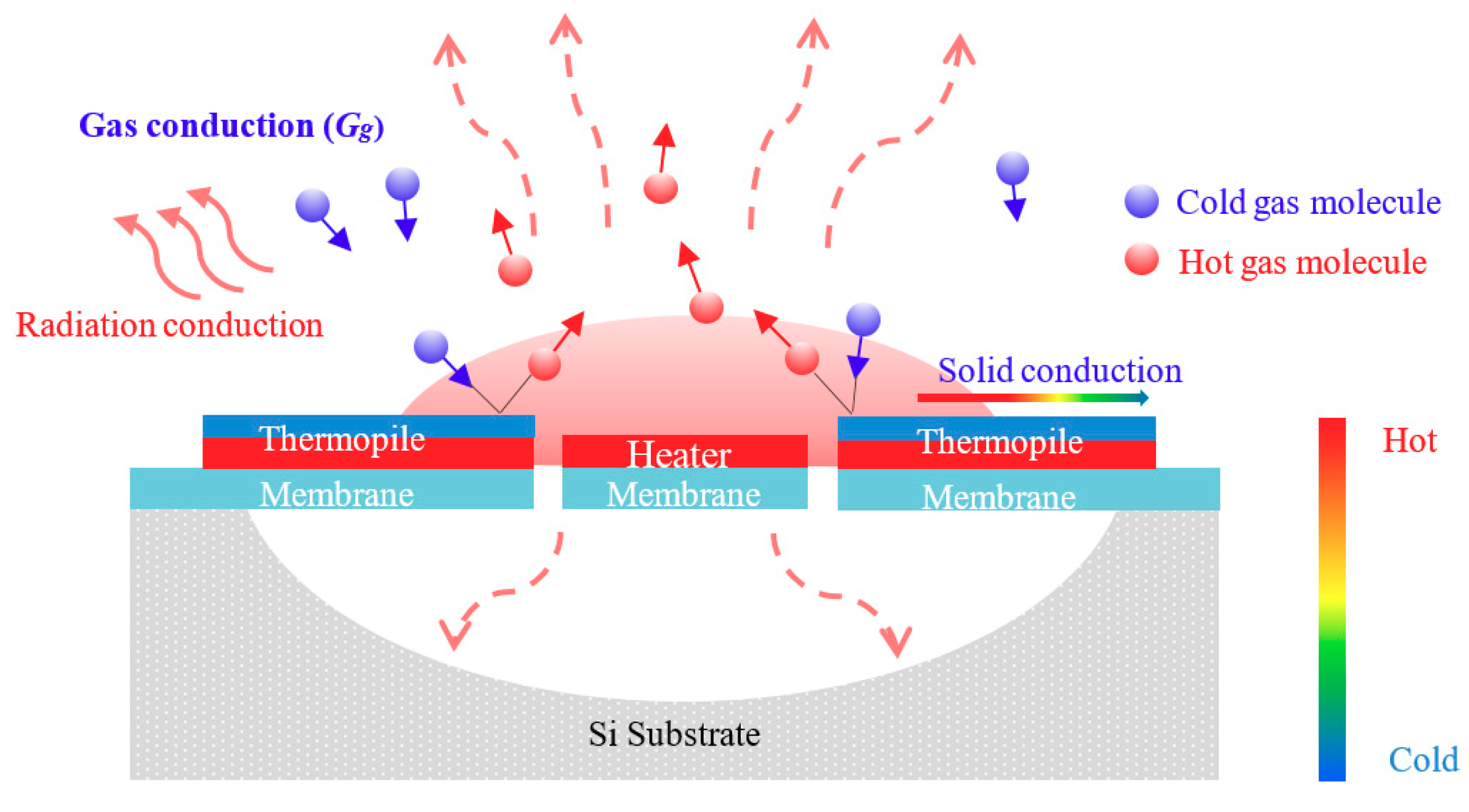
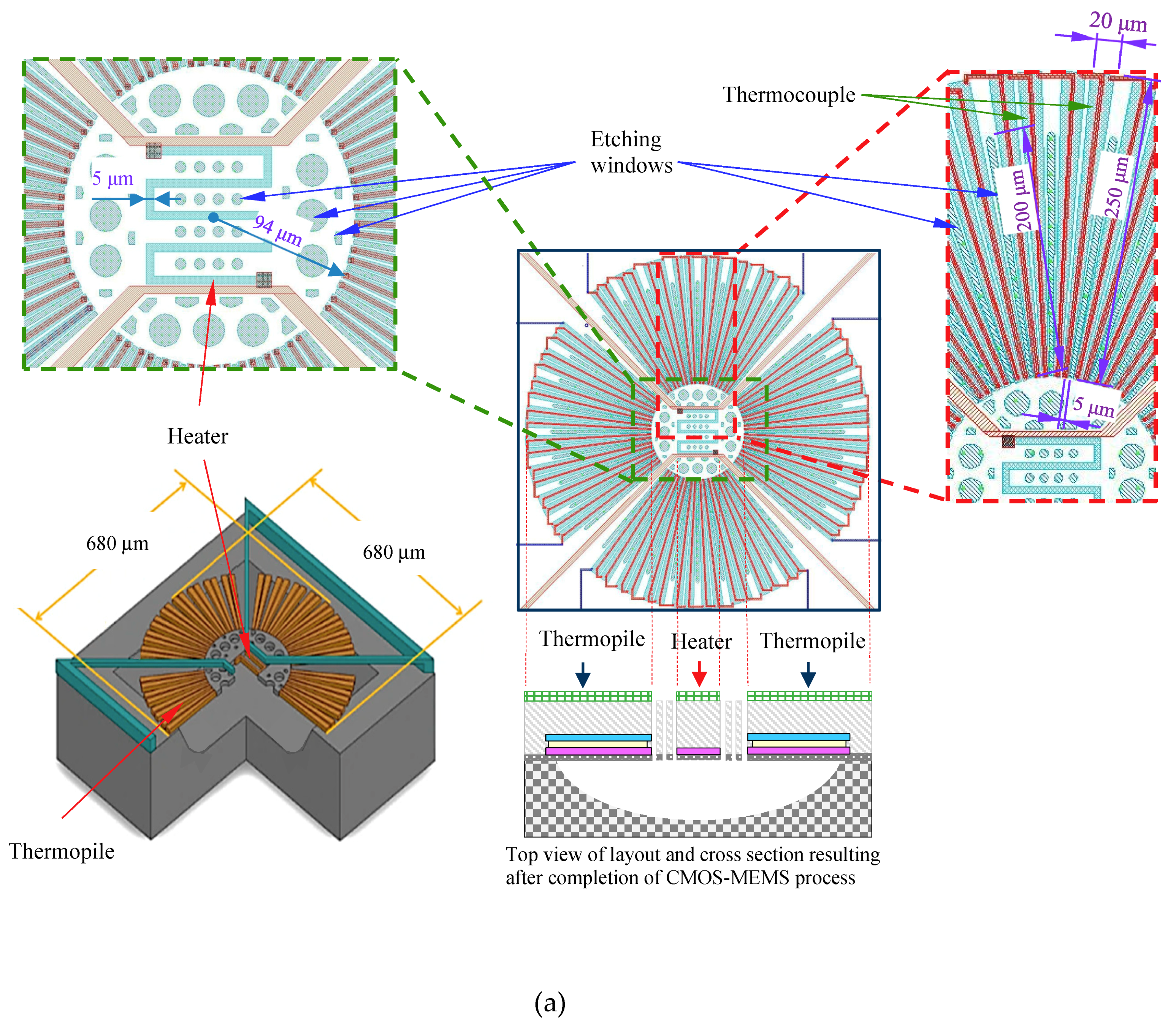
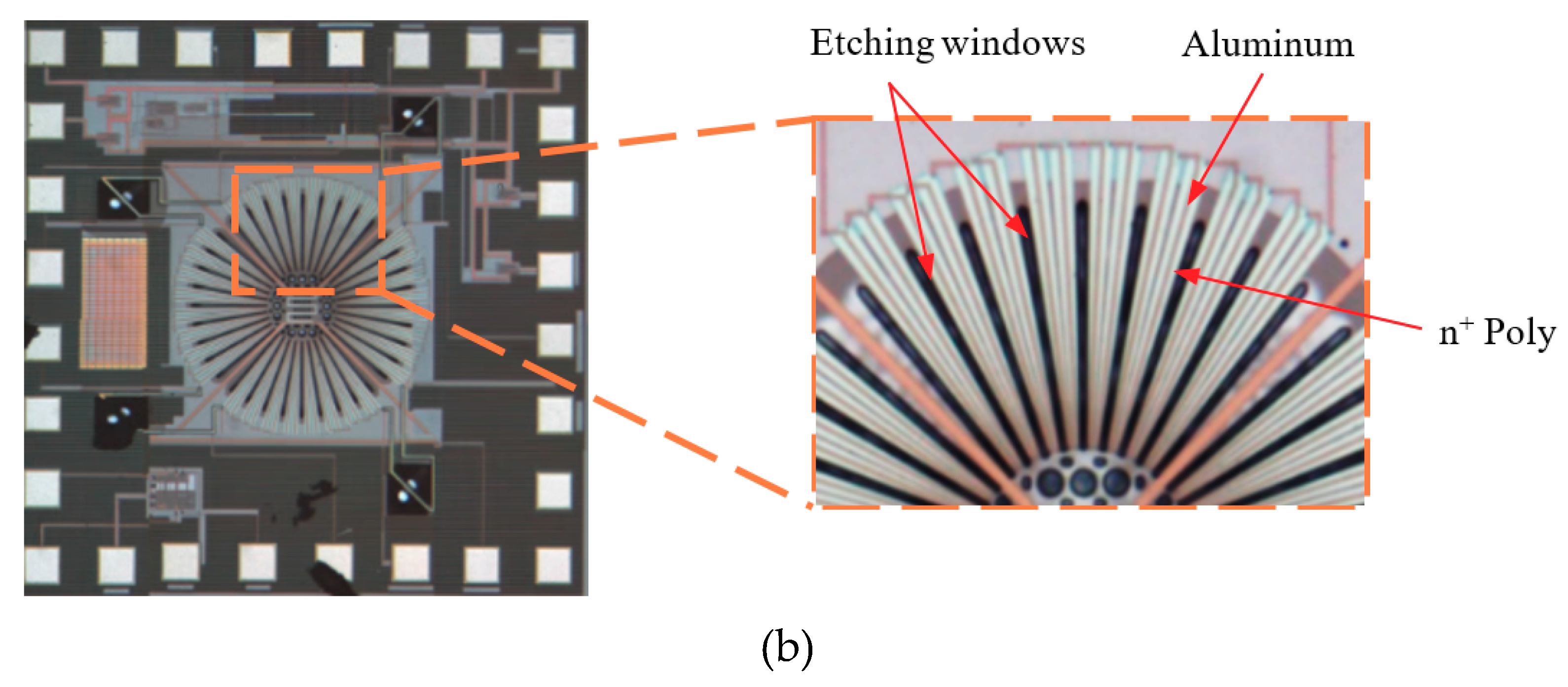
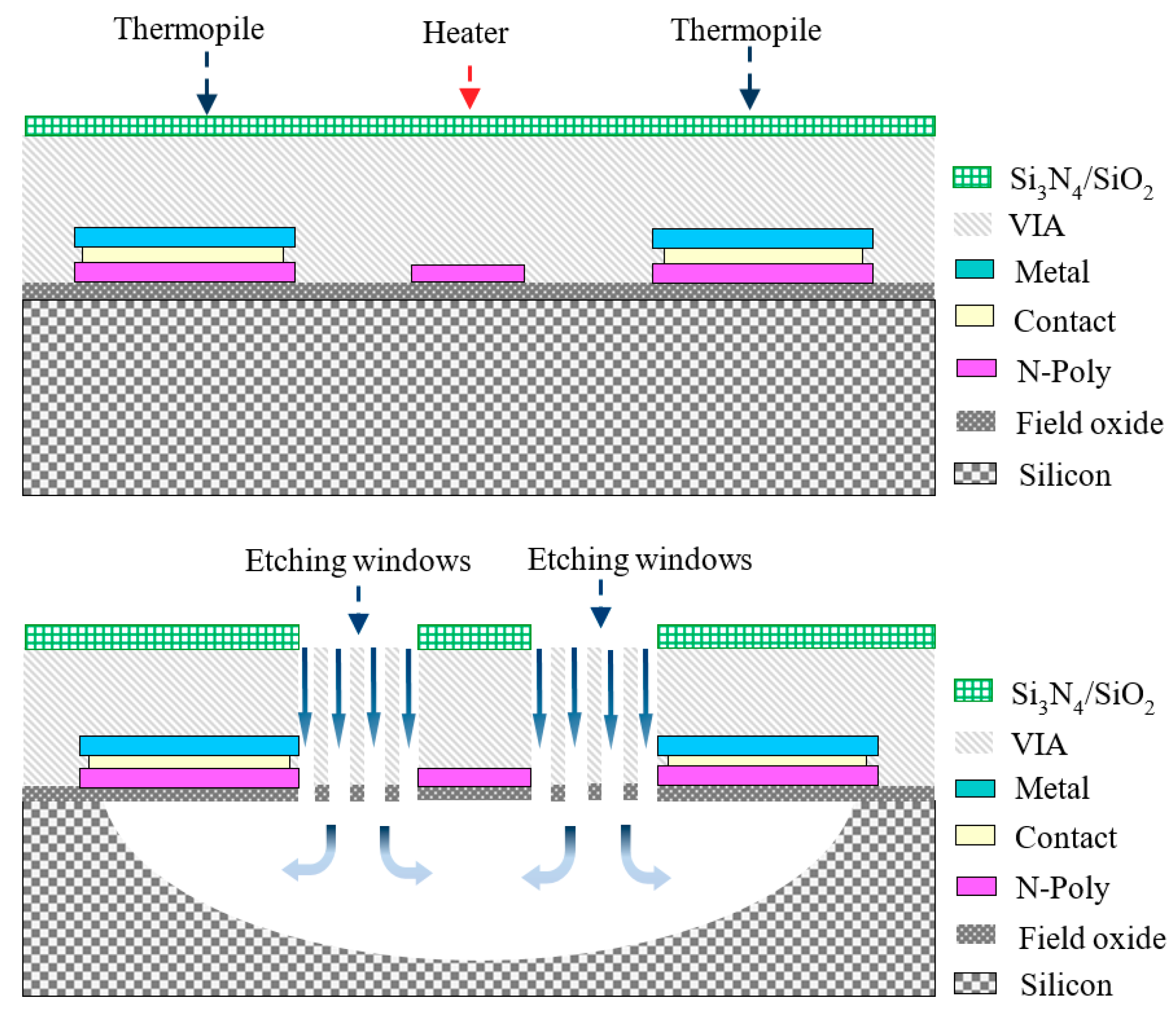
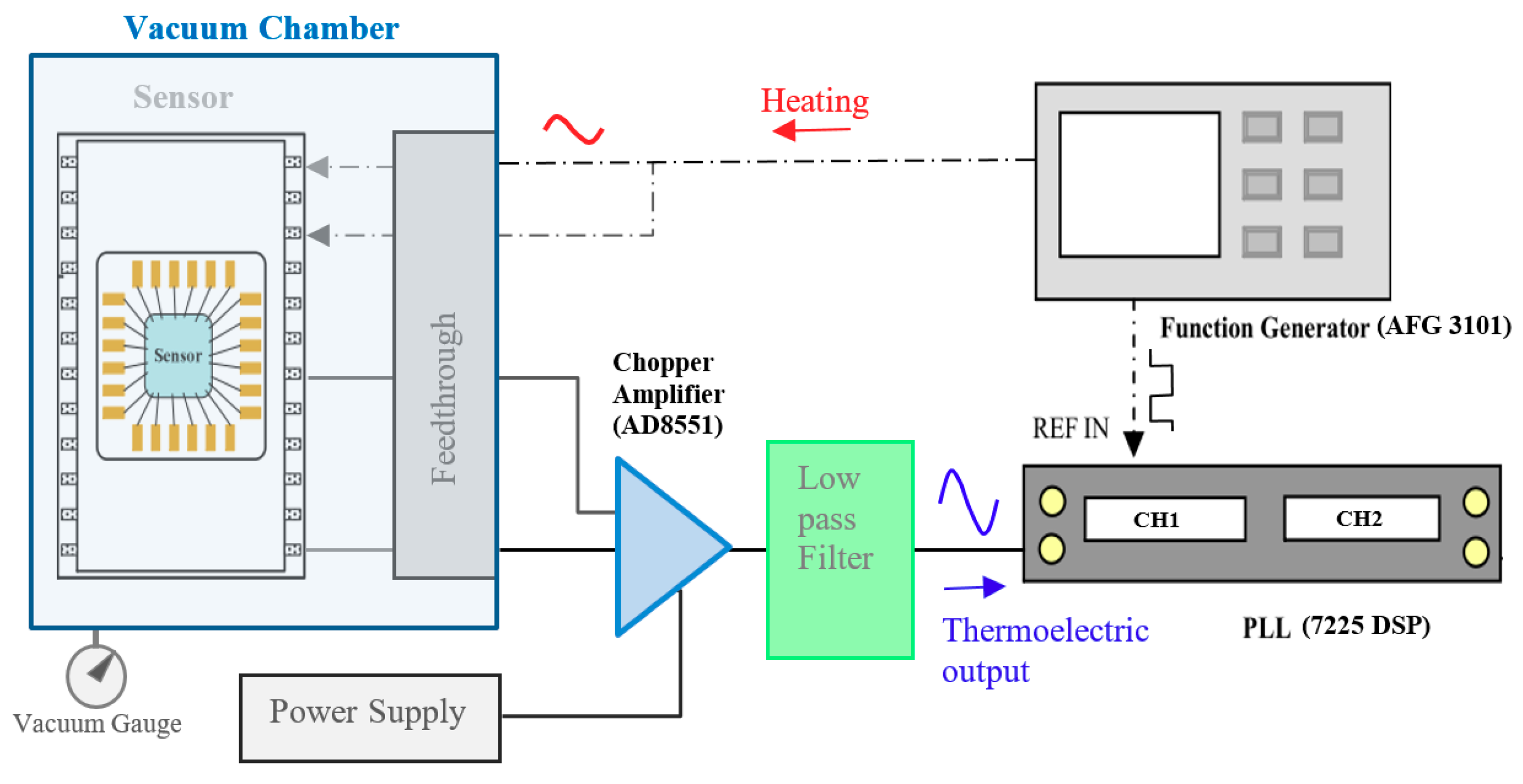

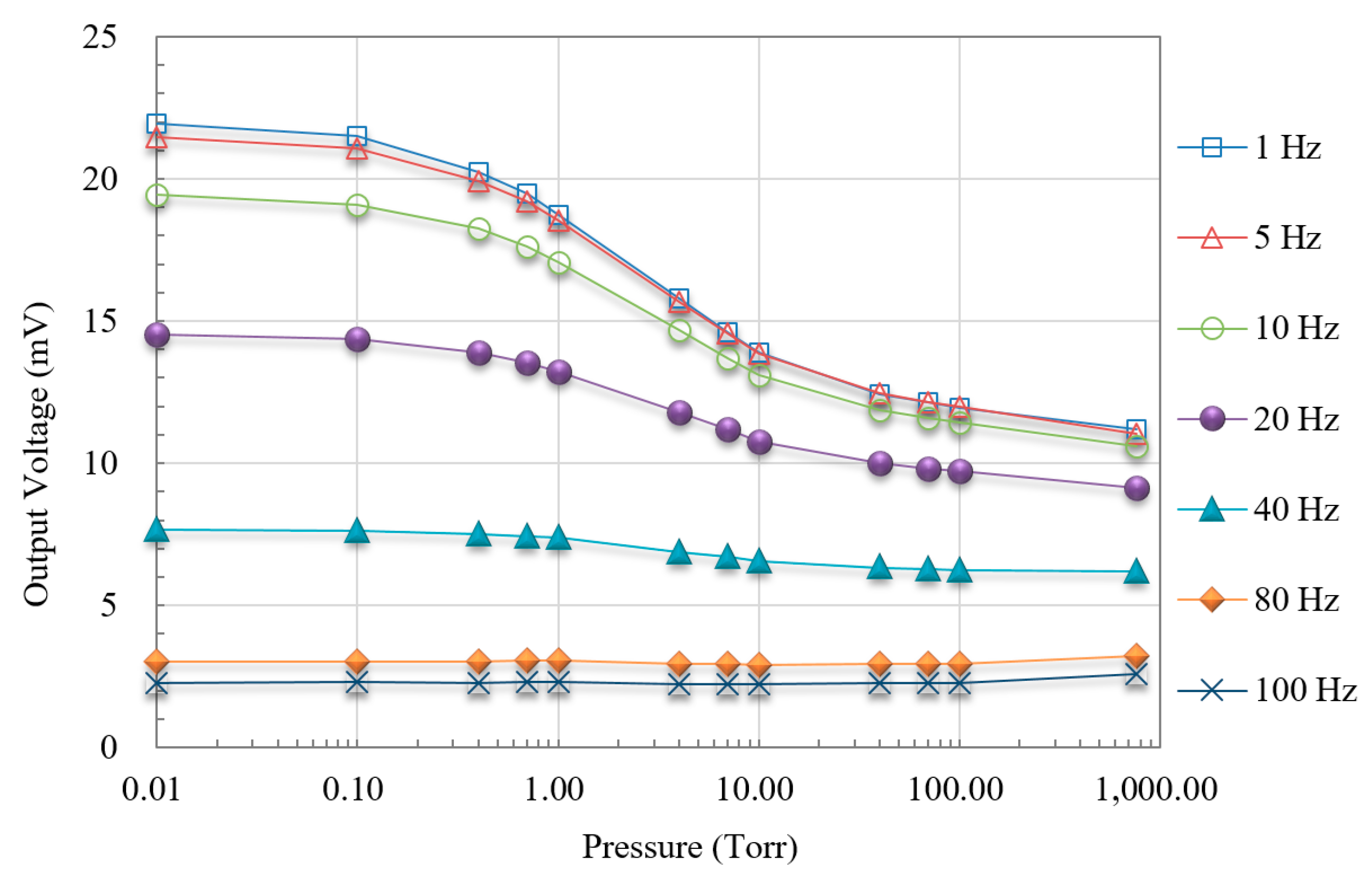
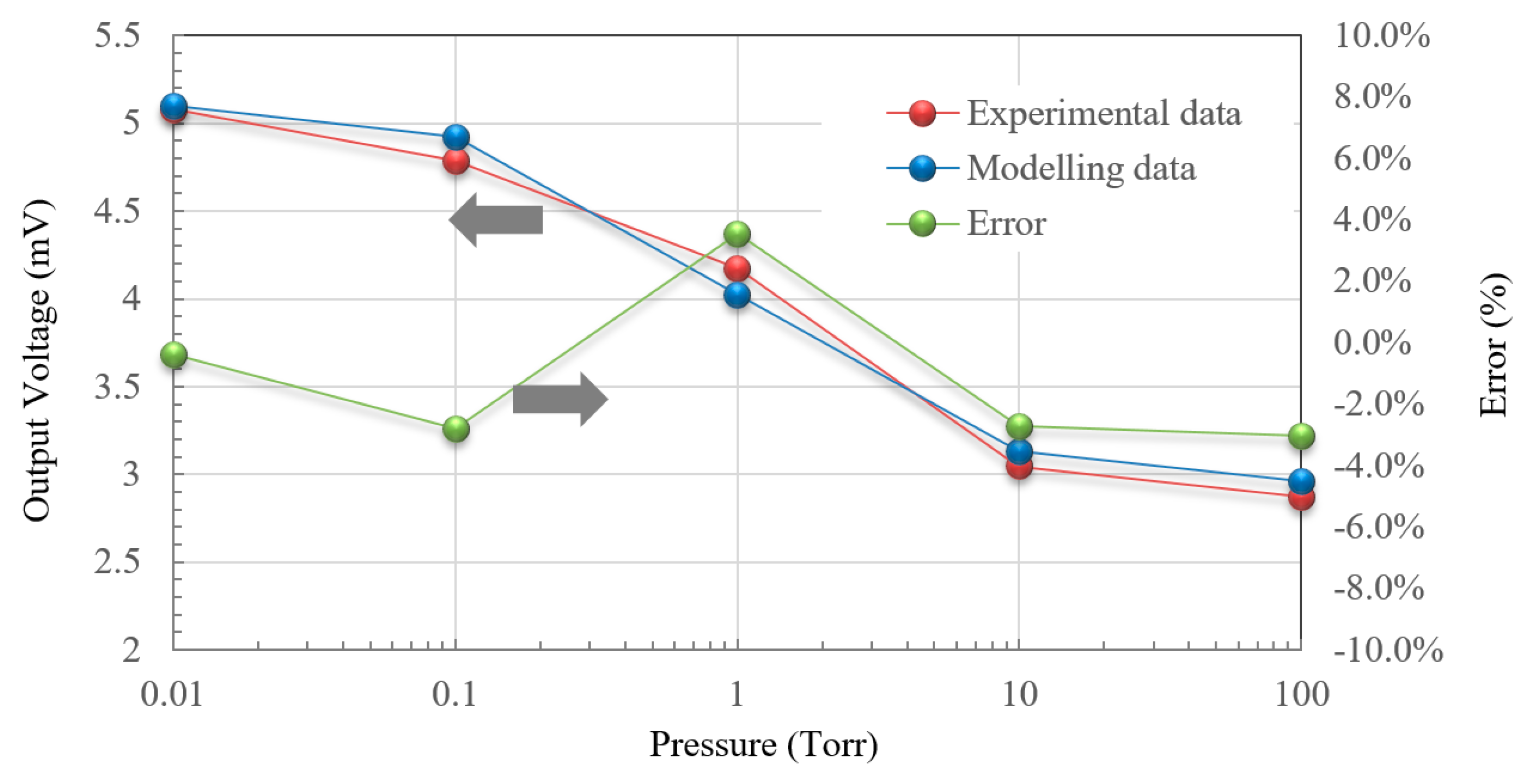
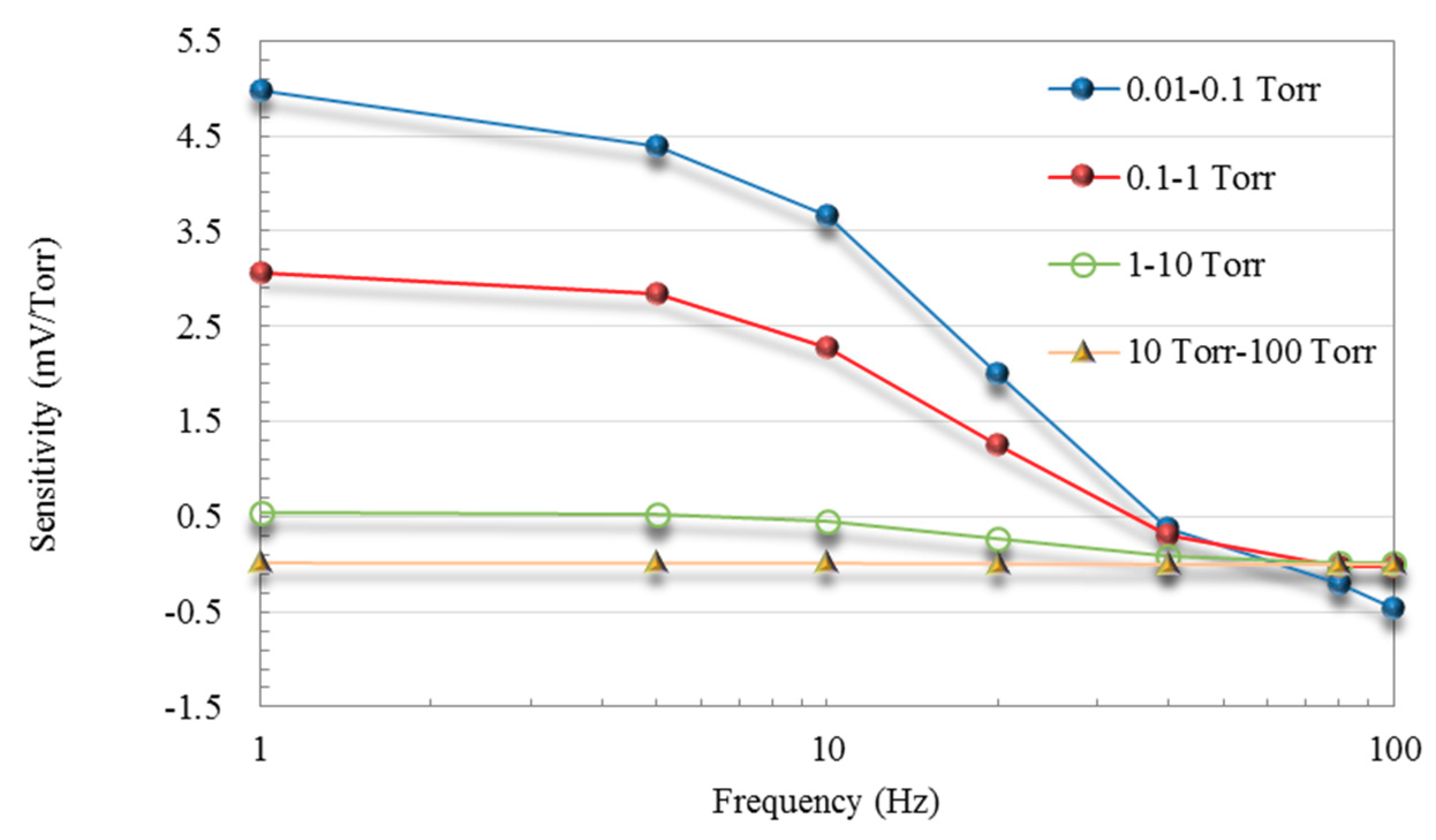
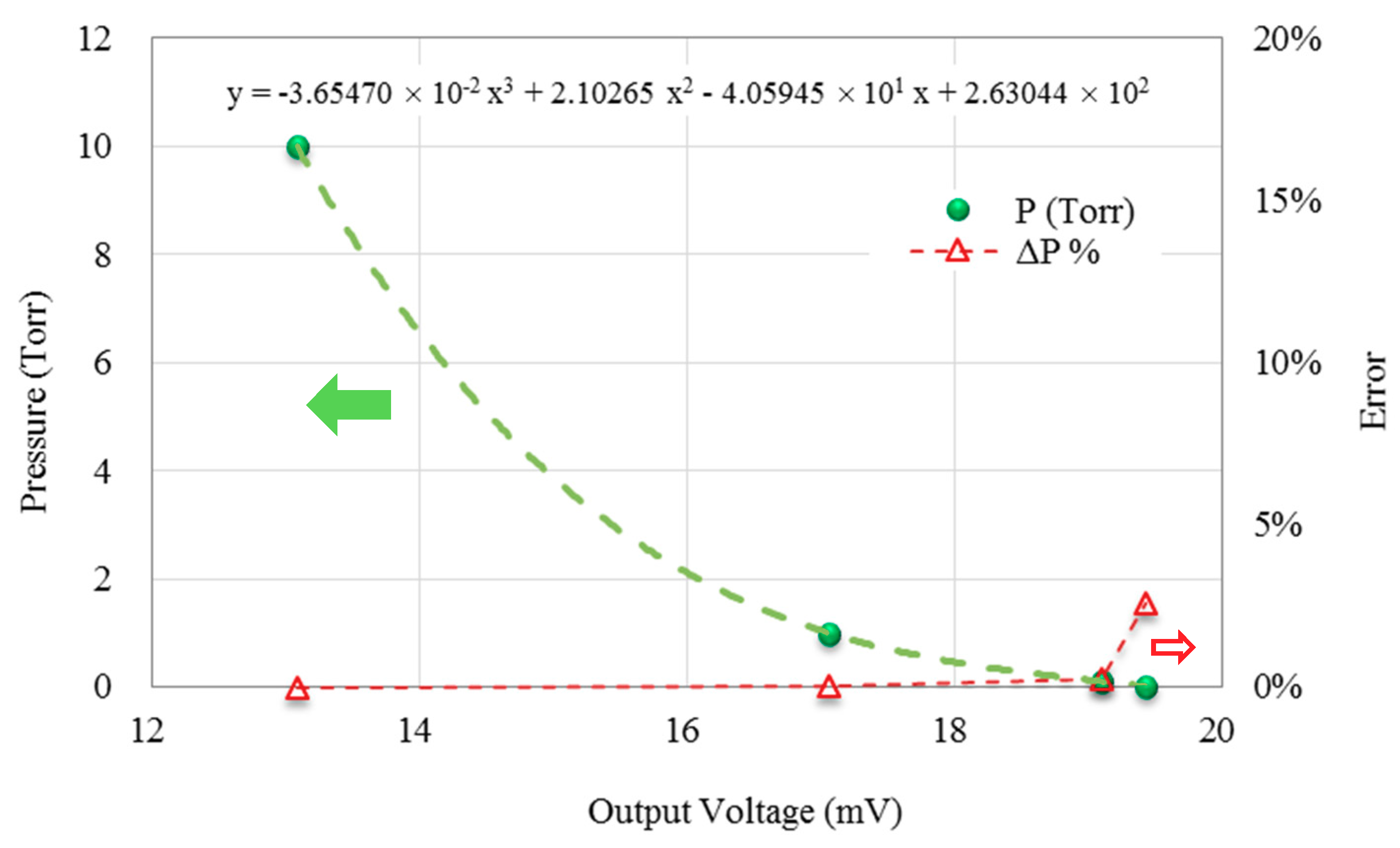
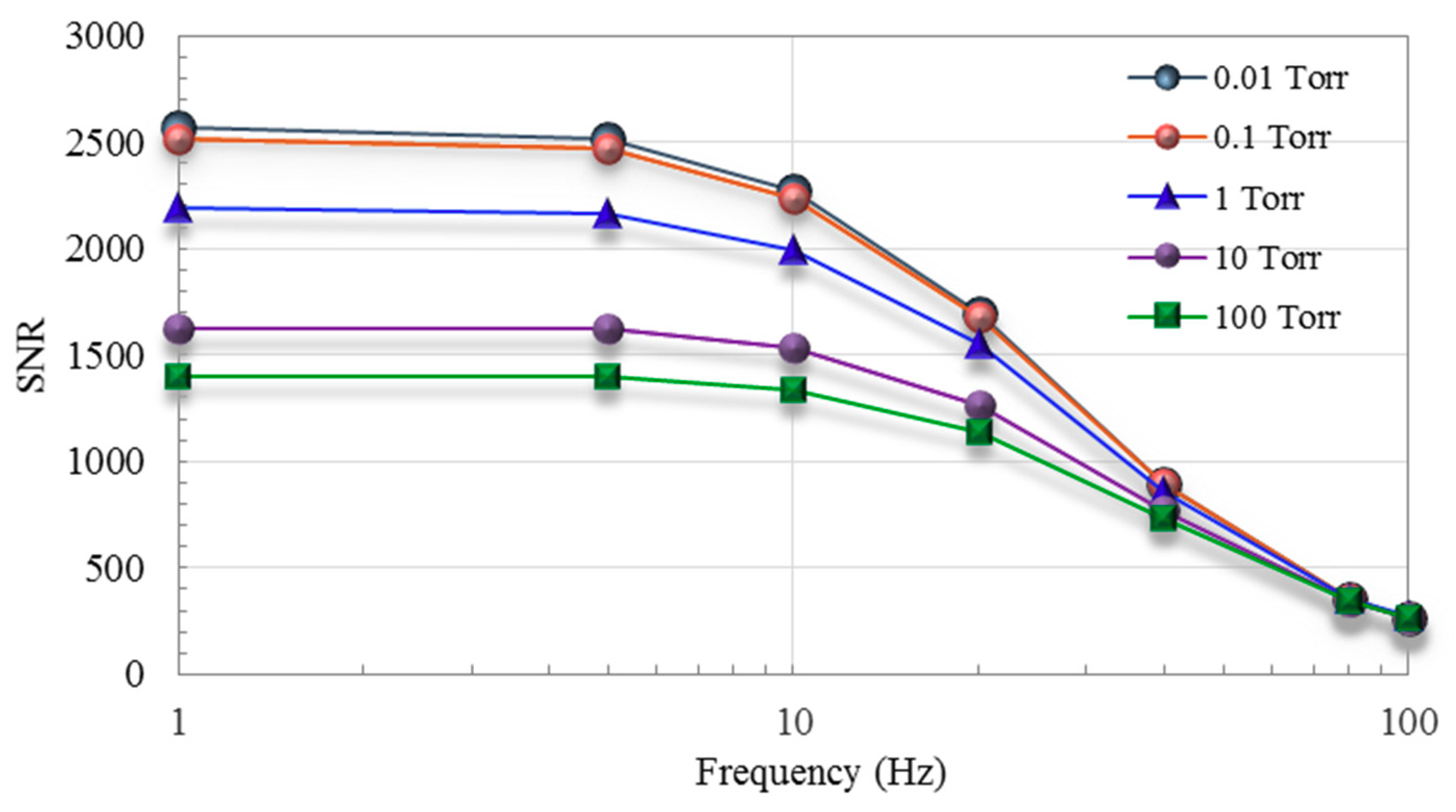

| Parameter | Typical Values |
|---|---|
| Chip size | 1500 μm × 1500 μm |
| Diameter of membrane | 680 μm |
| Number of thermocouples | 64 pairs |
| Size of heater | 460 μm × 5 μm |
| Size of etching window | 200 μm × 4.5 μm |
| Size of thermocouples | 250 μm × 20 μm |
| Parameter | Typical Values | Unit |
|---|---|---|
| Sensitive area | 680 × 680 | mm2 |
| Sensitivity | 4.98 1 | mV/Torr |
| Resistance | 14.8 | kΩ |
| SNR | 2568 1 | - |
| Time constant | 20 | ms |
© 2019 by the authors. Licensee MDPI, Basel, Switzerland. This article is an open access article distributed under the terms and conditions of the Creative Commons Attribution (CC BY) license (http://creativecommons.org/licenses/by/4.0/).
Share and Cite
Chen, S.-J.; Wu, Y.-C. Active Thermoelectric Vacuum Sensor Based on Frequency Modulation. Micromachines 2020, 11, 15. https://doi.org/10.3390/mi11010015
Chen S-J, Wu Y-C. Active Thermoelectric Vacuum Sensor Based on Frequency Modulation. Micromachines. 2020; 11(1):15. https://doi.org/10.3390/mi11010015
Chicago/Turabian StyleChen, Shu-Jung, and Yung-Chuan Wu. 2020. "Active Thermoelectric Vacuum Sensor Based on Frequency Modulation" Micromachines 11, no. 1: 15. https://doi.org/10.3390/mi11010015
APA StyleChen, S.-J., & Wu, Y.-C. (2020). Active Thermoelectric Vacuum Sensor Based on Frequency Modulation. Micromachines, 11(1), 15. https://doi.org/10.3390/mi11010015




